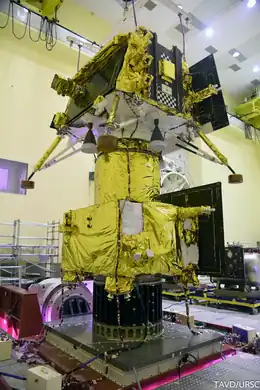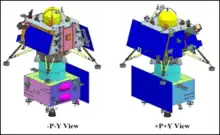Chandrayaan-3
Chandrayaan-3 (candra-yāna, transl. "mooncraft";[2][3] ![]() pronunciation ) is a planned third lunar exploration mission by the Indian Space Research Organisation (ISRO).[4] It would consist of a lander and a rover similar to the Chandrayaan-2 but would not have an orbiter. Its propulsion module will behave like a communications relay satellite. The Propulsion module will carry the lander and rover configuration till 100 km lunar orbit.[5][6]
pronunciation ) is a planned third lunar exploration mission by the Indian Space Research Organisation (ISRO).[4] It would consist of a lander and a rover similar to the Chandrayaan-2 but would not have an orbiter. Its propulsion module will behave like a communications relay satellite. The Propulsion module will carry the lander and rover configuration till 100 km lunar orbit.[5][6]
 Chandrayaan-3 Integrated Module going through Dynamic Testing | |
| Mission type | Lunar lander, rover, Propulsion Module |
|---|---|
| Operator | Indian Space Research Organisation (ISRO) |
| Website | www |
| Spacecraft properties | |
| Bus | Chandrayaan |
| Manufacturer | Indian Space Research Organisation (ISRO) |
| Payload mass | Propulsion Module: 2148 kg Lander Module: 1752 kg including Rover of 26 kg Total: 3900 kg |
| Start of mission | |
| Launch date | July 2023 (planned)[1] |
| Rocket | Launch Vehicle Mark-3 (LVM 3) |
| Launch site | Satish Dhawan Space Centre |
| Contractor | Indian Space Research Organisation (ISRO) |
| Moon lander | |
| Spacecraft component | Rover |
| Landing site | Lunar south pole |
The Propulsion module has Spectro-polarimetry of Habitable Planet Earth (SHAPE) payload to study the spectral and Polari metric measurements of Earth from the lunar orbit.[6][5] The spacecraft is scheduled to be launched in July 2023.[1]
Following Chandrayaan-2, where a last-minute software glitch in the soft landing guidance software led to the failure of the lander's soft landing attempt after a successful orbital insertion, another lunar mission was proposed.[7]
Background
In the second phase of the Chandrayaan programme to demonstrate soft landing on the Moon, ISRO launched Chandrayaan-2 on board a Launch Vehicle Mark-3 (LVM 3) launch vehicle consisting of an orbiter, a lander and a rover. The lander was scheduled to touchdown on the lunar surface in September 2019 to deploy the Pragyan rover.[8][9]
Earlier reports had emerged about a collaboration with Japan on a mission to the lunar south pole where India would be providing the lander while Japan would provide both launcher and rover. The mission may include site sampling and lunar night survival technologies.[10][11]
The subsequent failure of the Vikram lander led to the pursuit of another mission to demonstrate the landing capabilities needed for the Lunar Polar Exploration Mission proposed in partnership with Japan for 2025.[12] During mission critical flight operations, the European Space Tracking (ESTRACK) operated by European Space Agency (ESA) will support the mission according to a contract.[13]
Design

The lander for Chandrayaan-3 will have only four throttle-able engines,[14] unlike Vikram on Chandrayaan-2 which had five 800 Newtons engines with a fifth one being centrally mounted with a fixed thrust. Additionally, the Chandrayaan-3 lander will be equipped with a Laser Doppler Velocimeter (LDV).[15] The impact legs are made stronger compared to Chandrayaan-2 and increased instrumentation redundancy. ISRO is working on improving the structural rigidity and adding multiple contingency systems.[16]
Funding
In December 2019, it was reported that ISRO requested the initial funding of the project, amounting to ₹75 crore (US$9.4 million), out of which ₹60 crore (US$7.5 million) will be for meeting expenditure towards machinery, equipment and other capital expenditure, while the remaining ₹15 crore (US$1.9 million) is sought under revenue expenditure head.[17]
Confirming the existence of the project, ISRO's former chairman K. Sivan stated that the cost would be around ₹615 crore (US$77 million).[18]
See also
References
- "ISRO's missions to moon, sun likely to take place in July". Hindustan Times. 6 May 2023. Retrieved 7 May 2023.
- Monier Monier-Williams, A Sanskrit-English Dictionary (1899): candra: "[...] m. the moon (also personified as a deity Mn. &c)" yāna: "[...] n. a vehicle of any kind , carriage , wagon , vessel , ship , [...]"
- "Chandrayaan-2 FAQ". Archived from the original on 29 June 2019. Retrieved 24 August 2019.
The name Chandrayaan means "Chandra- Moon, Yaan-vehicle", – in Indian languages (Sanskrit and Hindi), – the lunar spacecraft
- "Press Meet - Briefing by Dr. K. Sivan, Chairman, ISRO". isro.gov.in. 1 January 2020. Archived from the original on 5 October 2021. Retrieved 3 January 2020.
- "Chandrayaan-3 to cost Rs 615 crore, launch could stretch to 2021". The Times of India. 2 January 2020. Retrieved 3 January 2020.
- "NASA - NSSDCA - Spacecraft - Details".
- Guptan, Mahesh (16 November 2019). "How did Chandrayaan 2 fail? ISRO finally has the answer". The Week. Retrieved 3 January 2020.
- Singh, Surendra (5 August 2018). "Chandrayaan-2 launch put off: India, Israel in lunar race for 4th position". The Times of India. Retrieved 15 August 2018.
- Shenoy, Jaideep (28 February 2016). "ISRO chief signals India's readiness for Chandrayaan II mission". The Times of India. Retrieved 3 January 2020.
- "India's next Moon shot will be bigger, in pact with Japan". The Times of India. 7 July 2019. Retrieved 3 January 2020.
For our next mission — Chandrayaan-3 — which will be accomplished in collaboration with JAXA (Japanese Space Agency), we will invite other countries too to participate with their payloads.
- "Episode 82: JAXA and International Collaboration with Professor Fujimoto Masaki". Astro talk UK. 4 January 2019. Retrieved 3 January 2020.
- ISRO Will Embark on Chandrayaan-3 by November 2020 for Another Landing Attempt The Wire, 14 November 2019
- "ESA and Indian space agency ISRO agree on future cooperation". www.esa.int. Retrieved 16 April 2022.
- Kumar, Chethan (15 September 2020). "Chandrayaan-3: No 5th engine on lander". The Times of India. Archived from the original on 15 September 2020. Retrieved 15 September 2020.
- Kumar, Chethan (19 November 2019). "Chandrayaan-3 plans indicate failures in Chandrayaan-2". The Times of India. Archived from the original on 21 November 2019. Retrieved 15 September 2020.
- Sharma, Shaurya (21 October 2022). "Chandrayaan-3 To Be More Robust, Have Contingency Systems Onboard, Says ISRO Chief". News18. Retrieved 22 October 2022.
- Kumar, Chethan (8 December 2019). "ISRO seeks 75 crore more from Centre for Chandrayaan-3". The Times of India. Retrieved 8 December 2019.
- "Chandrayaan-3 to cost Rs 615 crore, launch could stretch to 2021". The Times of India. 2 January 2020. Retrieved 3 January 2020.

